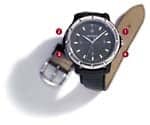Think about the cellular phone you used 6 years ago compared to the one you depend on today and unless you’re the type of person who’s never met an upgrade they couldn’t ignore, chances are very good that the differences between the two devices in terms of capabilities and features are vast. That dependable Motorola V120 you might have lugged around back then seems distinctly quaint when measured against the iPhone and BlackBerry you don’t leave home without today.
It’s easy to look back over the evolution of any of a variety of technologies and be amazed at how quickly things have changed. This holds true for wireless devices and how far the hearing industry has come with them in just a few years. Don’t believe me? Then come along for this nostalgic trip back along a timeline of articles published on the subject in a variety of hearing publications. First stop? Those prehistoric times of 2004—July, to be more exact.
Blue … who? Back then, Bluetooth wasn’t the prevalent term it is today. In fact, the technology that’s so standard now was barely a gleam in the hearing industry’s eye, as evidenced by this do-it-yourself tutorial published online by hearing aid wearer (and electrical engineer) Neil Ferguson, who introduced his Build a Bluetooth Adapter for Your Hearing Aids, as follows:
Read All @bout It:
Bluetooth Headsets & Hearing Aids
Many of you who read this will be only too aware of the way a mobile telephone can render a hearing aid useless by way of radio frequency interference (RFI). Of course, the closer the phone gets to the hearing aid, the worse the problem becomes, and by the time it’s next to the aid, virtually nothing but the RFI is audible. As a result, hearing aid users are generally excluded from using mobile telephones for voice calls, although SMS has proven popular as a partial alternative.
Naturally, people always try to find ways to get around problems like this. Some are lucky enough to be able to take their hearing aid out and compensate with the phone’s volume control. Others have relatively RFI-resistant hearing aids, so that they can use the hands-free induction couplers produced by the more attentive manufacturers. These devices let the user keep the phone a meter or so away from the hearing aid, thus attenuating the RFI.
Unfortunately, my hearing loss is sufficiently severe that neither of these workarounds is an option. For a verbal conversation where I can’t lipread the other person, I must have the 80 decibels of frequency-dependent boost that my hearing aids provide. Taking them out is not an option, and using such powerful amplification means that the hearing aid can clearly receive RFI from a mobile phone two meters away. No amount of extension cable will make a wired hands-free usable—the wire always conducts enough RFI to cause trouble, regardless of any filters that might be in place.
THE BOOK OF ELI
It was around 2005 when Starkey Laboratories, Eden Prairie, Minn, introduced the ELI (Ear Level Instrument), making it OK to put down the soldering gun and step away from Ferguson’s schematics.
According to Starkey Laboratories President Jerry Ruzicka, industry research indicated that hearing instrument wearers reported excellent results with their hearing devices in normal listening situations, but poorer results when they use the phone, for example, which can create feedback, static, and poor hearing instrument signal strength. When used with Bluetooth-enabled phones, ELI automatically overrode the hearing instrument’s microphone signal, essentially turning the instrument into a wireless cell phone headset. This dramatically improved the instrument’s sound quality and clarity while eliminating feedback and static problems.

Starkey’s ELI
Time magazine was so impressed with the Bluetooth-enabling device that it was included in the “Coolest Inventions” issue that year. Our sister publication, The Hearing Review, agreed in May 2005 with “A Wearable Bluetooth Device for Hard-of-Hearing People,” written by Jerry L. Yanz, PhD, Randall Roberts, and Jorge Sanguino, MSEE, who concluded with a look into ELI’s future:
Read All @bout It:
A Wearable Bluetooth Device For Hard-Of-Hearing People
Beyond telephones, one might use ELI to listen to television, stereo, the output of a computer or PDA, music from a Bluetooth-compatible MP3 player, or any number of additional Bluetooth devices that are now making their way into the marketplace.
Wireless technologies in hearing instruments will blossom in the next few years. Numerous possibilities are being explored, including true wireless programming, ear-to-ear binaural processing, improved directivity, and adaptive algorithms based on datalogging and neural networks, to name a few. The next few years promise exciting advances that will have an even greater impact on the hearing instrument market and the lives of the people we serve.
Future, indeed. Eight issues later, in January 2006, HR printed its next article on the innovation by Yanz, which opened with:

Phonak’s Smartlink remote module
Read All @bout It:
The Future of Wireless Devices in Hearing Care
Wireless is here to stay and has the potential to significantly affect the provision of hearing care. Hearing aids equipped with wireless systems will solve many of the most common issues encountered by hearing aid wearers, including telephone use, noise, and listening problems associated with distance, reverberation, and dynamic listening environments.
The feature further explored Starkey’s ELI as well as its SoundPort earset and then-upcoming BluePal wireless microphone products, along with the Smartlink remote module from Phonak, Warrenville, Ill.
NEW EPOQ DAWNS
Oticon’s entry into wireless connectivity, Epoq, was introduced by the Somerset, NJ-based company in April 2007, the first hearing device powered by Oticon’s newly developed wireless digital platform, RISE. Epoq featured a proprietary binaural high-speed wireless technology that enabled a pair of the hearing devices to communicate at data transfer speeds reportedly much faster than hearing instruments on the market at that time.

Oticon’s Epoq system
”Epoq allows hearing care professionals to address two distinct needs in one unified hearing solution—the ability to communicate efficiently and effectively with the world of ’near’ sounds such as human voice and environmental sounds and with the ’far away’ world of electronic communication through devices such as cell phones and MP3 players,” said Oticon President Peer Lauritsen. “We finally have a hearing instrument that goes beyond compensation for hearing loss to become a true high tech communications device.”
The following month in the May 2007 issue of HR, “Accessing the Far World: A New Age of Connectivity for Hearing Aids,” by George Lindley, PhD, AuD, appeared, in which he explained the connectivity systems:
This architecture was designed with connectivity as a core design feature. Incorporating earStream processing, communication between devices occurs at broadband speed. The Epoq hearing instruments can then work together, becoming one central processing unit. Going beyond simple binaural volume control and programming shifts, earStream technology allows the hearing instruments to share information at previously unseen speeds. Binaural signal processing algorithms that provide the user with a more natural and truer soundscape can be implemented.
The connectivity associated with these new hearing instruments increases exponentially when coupled with the Epoq Streamer device. The streamer serves as a gateway between the hearing instruments and devices with Bluetooth capability or an external audio port. Communication between the streamer and hearing instruments occurs wirelessly. The Epoq hearing instrument is designed to have the widest frequency response available, resulting in excellent sound quality for the end user. Importantly, the Epoq Streamer is intuitive and easy to operate, making it a viable option for most hearing aid users.
By now it was no longer just about embracing wireless connectivity, it was about how it could impact instrument design. Oticon’s RISE microchip platform, which uses near-field magnetic induction (NFMI) in virtually all aspects of the circuit’s performance, was considered a technology uniquely suited to hearing aid applications.
In “A New Epoch In Hearing History,” appearing in the July/August 2007 issue of Hearing Review Products, authors Gordon Wilson, MBA, Don Schum, PhD, and Lindley explained how NFMI works:
Read All @bout It:
A New Epoch In Hearing History
NFMI wireless technology is rapidly expanding into applications such as two-way radios and hands-free mobile phone earpieces, and some hearing instruments.1 NFMI works on the principle of magnetic induction, which is somewhat similar to a telecoil. With NFMI, however, communication can be two-way and the signal can be encoded for security purposes. Two devices or components each generate a special magnetic field, and communication takes place via an interaction between the fields.
NFMI is ideal for incorporation within hearing instruments because the components are very small and the power needs are minuscule. When active, the NFMI circuit in the Oticon RISE platform increases the power consumption of the chip by only 10%. Additionally, the magnetic field of the system does not extend beyond approximately 3 feet, which ensures secure encoded communication with a greatly reduced susceptibility to interference.
Until recently, hearing aids only made limited use of NFMI technology for basic applications such as bilateral control of the volume or program settings. Recent developments in the technology have allowed the transfer of information at speeds 100 times faster than before.
RELAY RACE
A popular as Bluetooth was, there was no hiding from a couple of important considerations. First, it was a solution limited to BTE hearing aids, and second, it’s very much a power hungry technology.
In the November 2007 issue of The Hearing Journal, Carl Sandrock and Donald J. Schum, PhD, wrote of NFMI’s use in “Wireless Transmission of Speech and Data To, From, and Between Hearing Aids,” not only because its size is smaller, but so is its appetite. The authors cited Epoq as a successful example.
In fact, in the Oticon product, the entire NFMI receiver is implemented in silicon on the hearing aid’s integrated circuit and is small enough to fit inside custom ITE aids.
Sandrock and Schum go on to discuss the benefits of NFMI as a two-way communicator, albeit over short distances:
Read All @bout It:
Wireless Transmission of Speech and Data To, From, and Between Hearing Aids
Advanced low-power design techniques and power management are used so the wireless functions add only 15% to the power consumption of today’s digital hearing aids. In its current form, communication is also two-way, meaning that the NFMI unit can act both as a receiver and as a transmitter. Its drawback is that it transmits and receives over short distances, up to about 1 meter.
Bluetooth signals are transmitted to hearings aids in the Oticon system via a gateway device, referred to as a streamer. In this arrangement, the audio source (let’s say a cell phone) transmits the audio signal via Bluetooth to the gateway device. The gateway device transforms the signal into an NFMI signal and then transmits that signal to the hearing aids.
Two years later, there were several horses in the wireless relay race. August Hernandez and Robert Martin wrote about them in “Binaural Hearing on the Telephone: Welcome to the 21st Century! “ in the April 2009 issue of The Hearing Journal:
Read All @bout It:
Binaural Hearing on the Telephone: Welcome to the 21st Century!
Every few years a new improvement comes along that truly makes a difference in people’s lives. One such innovation is the Bluetooth-compatible, remote control unit that relays incoming telephone calls directly to the wearer’s hearing instruments. Several manufacturers offer these units and their capacities depend on the specific model.

Siemens’ Tek
At the time this was written, four wireless relays (as they will generically be called here) with such capabilities are available: Epoq from Oticon, iCom from Phonak, sonicBLU from Sonic Innovations, and Tek from Siemens. These relays all operate uniquely and have a variety of features, such as volume control, tone control, etc.
Hernandez and Martin go on to explain the relays are user-friendly and in most cases easily connected to a cell phone.
All that’s required is to pair the relay to the phone as you would a Bluetooth earpiece. Pairing can be thought of as an introduction of one device to another and is a mandatory process in the Bluetooth protocol, which allows two devices to communicate securely over a globally unlicensed, short-range radio communications system. Simply activate the Bluetooth feature on the cell phone, search for the device, and the name of the relay unit will appear on the phone, permitting the connection to be made.
In “Digital Wireless Hearing Aids, Part 1,” found in the March 2010 issue of The Hearing Review, we find an in-depth examination of the topic by Francis Kuk, PhD, and a team of research engineers at Widex, Long Island City, NY.
While acknowledging that Bluetooth has become a standard for a variety of devices, Kuk also recognizes problems inherent in the technology that prevent hearing instruments from fully joining that wireless revolution led by notebook computers, cell phones, and PDAs:
Read All @bout It:
Digital Wireless Hearing Aids, Part 1: A Primer
However, the power consumption of Bluetooth is still not low enough to permit its integration into a hearing aid. A typical Bluetooth chip requires a current drain from 45 milliAmps (mA) to as high as 80 mA for operation. If a Bluetooth chip were embedded in a hearing aid that uses a #10 battery (with a capacity of 80 mAh), the battery would only last 1 to 2 hours before it expires!
Another problem with Bluetooth is the audio delay inherent in the standard Bluetooth audio profile. In creating a standard that is adaptable to many different devices, Bluetooth has to satisfy many procedures to ensure a proper communication link between devices. This delays the immediate transmission of signals. For example, a delay of up to 150 ms may be noted between the direct sound and the transmitted sound from a TV using Bluetooth. When a delayed audio signal is mixed with the direct signal, a poorer sound quality—ranging from a “metallic” sound to an “echo”—may be perceived depending on the amount of delay. Excessive delay, such as 150 ms, could lead to a dis-synchrony between the visual and audio signals.
FULL CIRCLE AND BEYOND
Introduced to much acclaim at the AudiologyNOW! convention in San Diego in April of this year, Bloomington, Minn-based ReSound’s Alera simultaneously evolved from and harkened back to Starkey’s ELI, while also eliminating the need of a relay.

ReSound Alera
Operating on the 2.4 GHz frequency, Alera, via the accompanying Unite wireless accessories, delivers audio directly from televisions, stereos, cell phones, and PCs with no blockage of environmental noise.
“With ReSound Alera, we have taken a huge step in making wireless hearing aids easier to use, and at the same time we are delivering unique performance and design,” said Peter Ulrik Scheel, the company’s senior vice president for research and development.
“Our technology is delivering groundbreaking advances in the field of wireless hearing aids. With the launch of ReSound Alera, GN ReSound has delivered a significant advance on a research initiative that has been under way for some time.” Alera, which won a Red Dot award for its design, became available this past August.
In the meantime, Starkey Laboratories has moved beyond the 2.4 GHz signal and developed 900 MHz implementation of wireless hearing aids, a technology Starkey has dubbed “Iris.”
In an article appearing in the October 2010 issue of The Hearing Journal, Jason Galster, PhD, Starkey’s director of audiology communications, writes:
Read All @bout It:
A New Method For Wireless Connectivity In Hearing Aids
The Iris wireless system is designed to offer long-distance audio streaming, wireless programming, and binaural signal processing, without need for an intermediate relay. For wireless audio streaming, a wireless media device, SURFLink Media, connects to the patient’s television or other media source and streams stereo audio directly to the hearing aids—up to 20 feet away. When a hearing aid enters the range of the media device, it can be programmed to detect that streaming device automatically and accept the new audio input.
For instance, if a patient returned home from work, her hearing aids could immediately begin streaming audio from the television when she entered the front door; or the option to manually initiate audio streaming is also available. An unlimited number of hearing aids can access a single SURFLink media device, without the need for pairing. If used in a group living environment, everyone wearing hearing aids with the Iris wireless technology can access the television’s audio by simply walking into the same room as the television. Disconnecting from the audio stream is as easy as leaving the room or tapping the memory button on the hearing aid.
What will they think of next? It’s only a matter of time.
Will Campbell is editor of Hearing Review Products magazine. He can be reached via e-mail at hearingreview@allied360.com.






